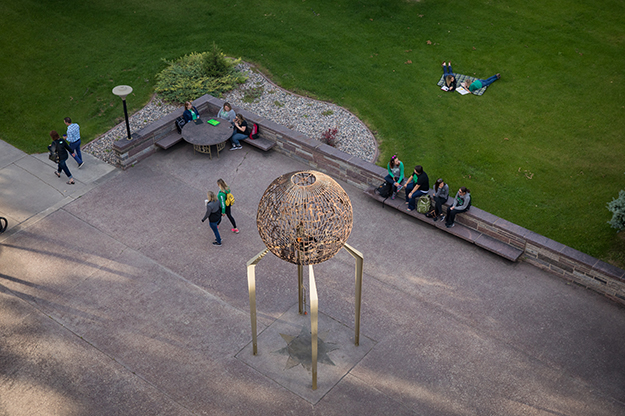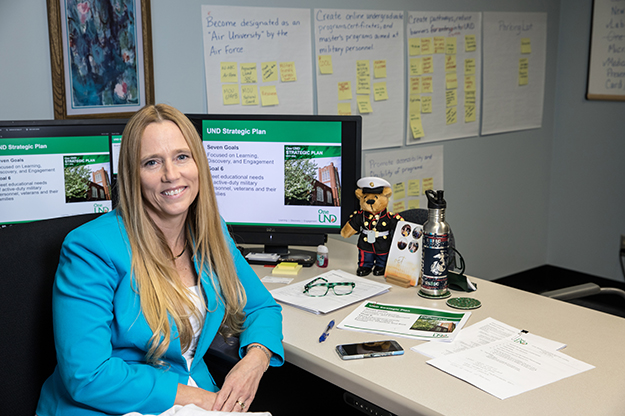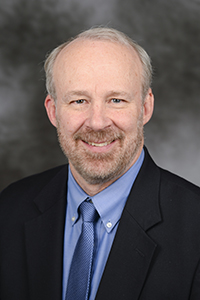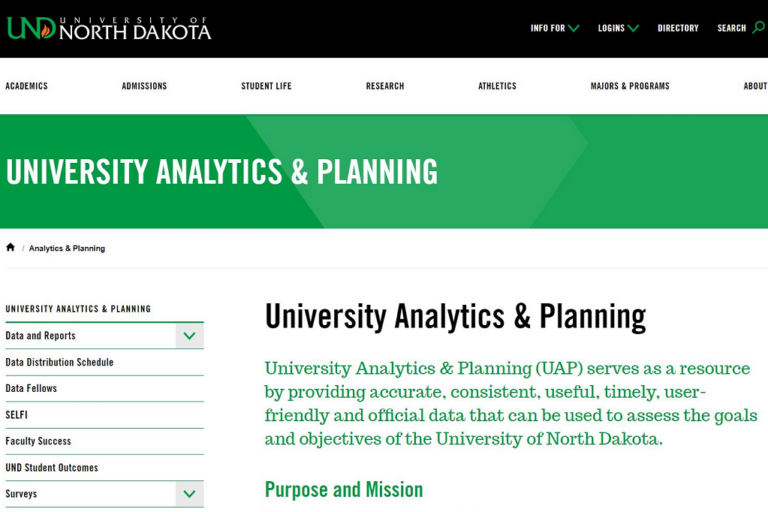Opportunity drivers
Strategic Plan project managers deliver plans to ignite military and online learning prospects

The purpose of the One UND Strategic Plan is simple: to help the University of North Dakota become the chief opportunity engine for North Dakota and UND students.
You need fuel to fire an engine, and Strategic Plan Goals No. 3 and No. 6 are filling up the opportunity tank – and they’re doing it fast.
A Nov. 9 Provost Forum, hosted by UND Provost Tom DiLorenzo, included progress updates from Sherry Lawdermilt, project manager of Goal No. 6 (meeting the educational needs of the active-duty military, veterans, and their families) and Jeff Holm, project manager of Goal No. 3 (deliver more educational opportunities on campus and online).

Military opportunity
Lawdermilt engaged the audience of the Education Building lecture hall first, detailing why her past makes her a perfect fit for the future of this mission.
“I enlisted in the Marine Corps right out of high school. While I was in the Marine Corps, I took some college courses,” she said, explaining how she utilized the tuition assistance and the GI Bill for both on campus and online courses. “I’ve had a lot of experience with what this goal is working towards.”
The team’s first step was finding out what degrees and programs are most in demand at the Grand Forks Air Force Base. They compiled additional assessments from other military bases in North Dakota, as well an evaluation of national wants and needs.
What they found was consistent. High-demand areas included business management, marketing, health sciences, computer information systems, criminal justice, aviation, engineering and general studies.
“With that in mind, the next action step is to work with Goal No. 3 to initiate these high-demand degrees and certificates aimed at military personnel. For that, we’ve started meeting bi-weekly,” Lawdermilt said.
Goal No. 6 also plans to create pathways and reducing barriers for entry to UND by working with individual Colleges to develop transfer credit equivalencies for military experience based on American Council on Education (ACE) recommendations.
Promoting the accessibility and flexibility of UND’s programs is essential, so Lawdermilt’s group is collaborating with UND Marketing to target that message to the military both locally and nationally. Becoming designated as an “Air University” will help in recruitment, and UND is close to getting its first degree, General Studies, online-ready for inclusion in the Air University Associate to Baccalaureate (AU-ABC) program.
Lawdermilt said that they are currently focused on enrollment goals, but the team plans to turn some focus to process improvement and retention for those who choose UND. “Once we get them here, we want to make sure they stay and complete their program,” she said.
On and off campus
Holm began his Goal No. 3 update by discussing the goal’s breadth, which includes marketing, admissions, financial assistance, enrollment processes, and the physical campus environment. He then spoke to fears about online education – that it’s inferior or that it takes away from the campus experience – and answered a question he often hears: “Why are we doing this?”

“We’re all in higher education because we have a passion and an interest in teaching and educating people,” he said. “But let’s face it – we have to be financially viable, too.”
Holm detailed how the national landscape of higher education is changing, with student loan debt climbing, universities downgrading/closing, and national tax proposals that potentially exacerbate the situation.
The University of North Dakota, Holm said, has to provide more educational opportunities, and quickly, to stay ahead of the curve. “If we’re not breaking things, we’re not moving fast enough,” he said, quoting Facebook CEO Mark Zuckerberg.
Holm laid out initial action steps of Goal No. 3, which include investments and developments in marketing and recruiting, as well as examining ways to optimize UND’s ability to attract and retain high-quality and diverse students through reducing admission barriers, leveraging scholarships and waivers, and upgrading the look and feel of campus.
Developing and promoting high-demand programs, like data analytics and cyber security, is another major task.
The team is crafting a strategic approach for synergy of programs by coordinating the development of certificates and degrees that will align into stackable verticals and academic suites. Holm said a partnership with an Online Program Management (OPM) company will help that aim, and they have been meeting with Pearson (the OPM that has managed Arizona State University’s explosive online growth) to see what a potential relationship would look like.
Holm said extra help from an OPM means extra online opportunities for the 37 million Americans who have only completed some of their degree due to life pulling them away – through military obligations, career changes, or family commitments.
“I want to provide those opportunities for them, and online courses are what those students prefer,” he said.
OPM questions
University Senate Chair Nancy Vogeltanz-Holm expressed that faculty have found it frustrating to build online programs with video, audio, and more, only to be met with upgrades or system changes that force constant maintenance.
“What is your corresponding plan to provide the resources we need to make this transition more seamless?” she asked.
“[An OPM] has the resources to provide the capability to prepare a better class, to provide a program that is better, and that would include some of the technology pieces,” Jeff Holm replied. “But there’s no doubt that we have to make that a focus as well.”
Tera Buckley, assistant marketing director of web and digital strategies, wondered how the accounting side of an OPM partnership would work.
“They typically take a percentage of the tuition revenue generated from a program. The amount that they take depends on the services and the capital that they provide,” Holm said. “It’s not a fee-for-service – you don’t pay them if you don’t have success. That’s why it’s best considered as a partnership, rather than a service that we are purchasing.”
Provost DiLorenzo concluded the conversation by noting the already incredible progress of the Strategic Plan.
“Over the course of the semester, you’ve seen more and more occurring,” he said. “Many of you are participating, and we want to thank you for helping us.”
The Provost’s fora will continue to be held in Education Building Room 7 from 3:30-4:30 p.m.
- 30 – Strategic Plan Goals Nos. 4 and 5
- 13 – Budget/MIRA/Goal No. 7 (note date change)


